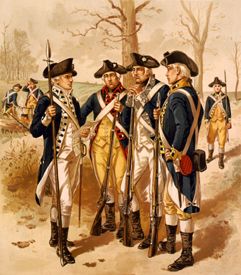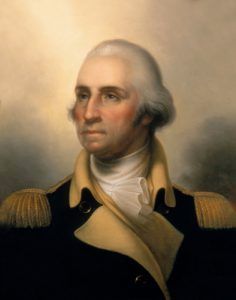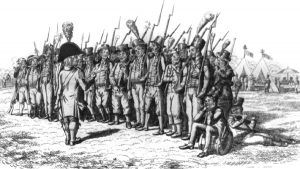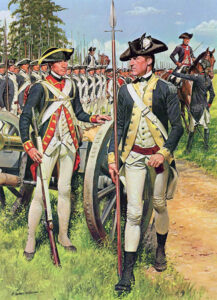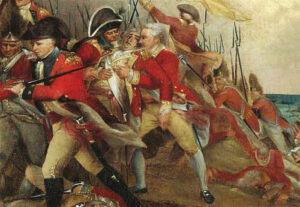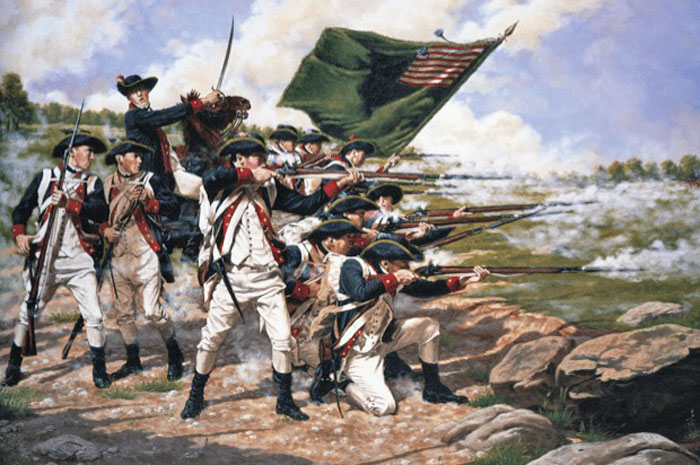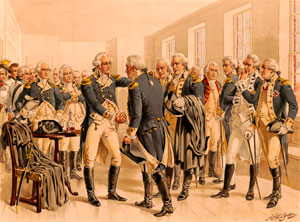The Continental Army represented the Thirteen Colonies in the American Revolution. The army was created to coordinate the military efforts of the colonies in the war against the British, who sought to maintain control over the American colonies. General George Washington was appointed commander-in-chief of the Continental Army and maintained this position throughout the war.
The response of King George III and his ministers to the events at Lexington, Concord, and Bunker Hill was a determined effort to subdue the rebellious colonists by force. It took time to mount this effort, and after Bunker Hill, the Americans enjoyed a respite lasting almost a year. During most of this period, the Second Continental Congress reacted to New England and New York events by hesitantly assuming the mantle of leadership. However, it continued to assert that these actions were defensive. It charged that Americans had banded together to oppose the unconstitutional actions of Parliament but still hoped to find a formula for reconciliation by appealing directly to the King for justice. Military preparations were designed for a short struggle to endure no longer than the end of the year 1776. Nevertheless, the Americans took advantage of the respite to create a national army, consolidate their hold on the governmental machinery throughout the thirteen colonies, invade Canada, and finally force the British to evacuate Boston, Massachusetts.
The creation of the Continental Army was, in the long run, perhaps their most significant achievement. The message was clear: This was not a regional outbreak of violence but was the united response of the mainland North American colonies. After determining the necessity of accepting national responsibility for the troops in Boston and New York, Congress voted to create the Continental Army on June 14, 1775, at a meeting in Philadelphia, Pennsylvania. On the same day, it voted to raise ten companies of riflemen — the first soldiers to be enlisted directly in the Continental Service — in Pennsylvania, Maryland, and Virginia to march north to join the army in Boston. Because of the need to preserve secrecy, Congress made its decision as a committee of the whole. Sometime before Bunker Hill, the Massachusetts Congress, aware of the necessity of enlisting the support of all the colonies in the struggle against the British, appealed to the Continental Congress to adopt the New England army.
The next day, June 15, Congress chose George Washington, a Virginian, to be Commander in Chief. As with the riflemen, Congress chose geographical and political reasons as much as military ones. The New Englanders felt a Southerner should be chosen for the post to prove this was not a New England-only conflict. Washington’s military experience was perhaps more significant than any other American, coming from the largest and most important southern colonies. His impressive appearance, quiet and confident manner, and good work on the military committees of Congress impressed everyone.
The choice proved fortunate. When he accepted the command, Washington recognized that he lacked the requisite experience and knowledge to handle large bodies of men. His whole military experience was frontier warfare during the French and Indian War. But he had commanded a brigade of troops from several colonies during the capture of Fort Duquesne in the war — he was the only native-born American up to that time to command a force of that size. Experience gained as a political leader in his native Virginia and in directing the business affairs of his extensive plantation at Mount Vernon also stood him in good stead. He brought to the task traits of character and abilities as a leader that, in the end, more than compensated for his lack of European military experience. Among these qualities were a determination and a steadfastness of purpose rooted in an unshakable conviction of the righteousness of the American cause, a strict sense of honor and duty, and a dignity that inspired respect and confidence in those around him. Conscious of his defects, he was always willing to profit from the experience. From the trials and tribulations of eight years of war, he was to learn the essentials of strategy, tactics, and military organization.
Congress appointed four major generals and eight brigadiers to serve under Washington, set up a series of staff offices closely resembling those in the British Army, prescribed a pay scale and standard ration, and adopted Articles of War to govern the military establishment. The same mixture of geographical, political, and military considerations governed the choice of Washington’s subordinates. Two-thirds came from New England, recognizing that the existing army was a New England army. Three others — Charles Lee, Horatio Gates, and Richard Montgomery — were chosen because of their experience in the British Army. Lee, in particular, who had come from England to the colonies in 1773, was in 1775 deemed the foremost military expert in America, and he was for a time to be Washington’s first assistant.
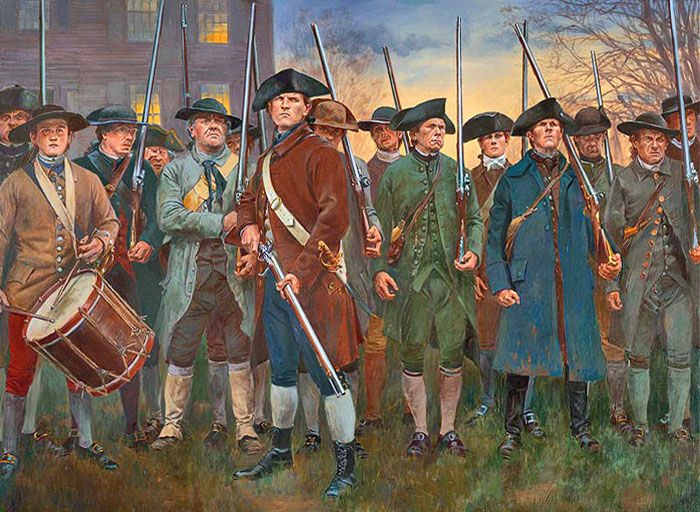
Continental Army by Don Troiani.
Washington formally took command of the army on July 3, 1775, which he described as “a mixed multitude of people… under minimal discipline, order or government.” Out of this mixed multitude, Washington created an army primarily shaped by the British image. Based on his experience with British regulars during the French and Indian War, he wrote: “Discipline is the soul of an army. It makes small numbers formidable; procures success to the weak and esteem to all.” Employing Gates, his experienced Adjutant General, to prepare regulations and orders, the Commander in Chief set out to teach discipline. He and his staff made a strenuous effort to halt the random comings and goings of officers and men and to institute regular roll calls and strength returns. Suspicious of the “leveling” tendencies of the New Englanders, Washington made the distinction between officers and enlisted men more rigid. He introduced various punishments (lash, pillory, wooden horse, and drumming out of camp), and courts-martial sat almost constantly.
While establishing discipline in the existing army, Washington had, at the same time, formed a new one and enlisted directly in the Continental service. Out of conferences with a congressional committee that visited the camp in September 1775 emerged a plan for such an army, composed of 26 regiments of infantry of 728 men each, plus one regiment of riflemen and one of artillery, 20,372 men in all, to be uniformly paid, supplied, and administered by the Continental Congress and enlisted to the end of the year 1776. Except for the short term of enlistment, it was an excellent plan on paper, but Washington soon found he could not carry it out. Both officers and men resisted a reorganization that cut across the lines of the locally organized units they were accustomed to serving. The men saw their families and farms at home as their first obligation, and they were reluctant to reenlist for another year’s service. On December 10, despite pressures and patriotic appeals, many Connecticut men went home, and militia from New Hampshire and Massachusetts had to be brought in to fill their places in the line. Others, who had jeered and hooted when the Connecticut men left, also went home only three weeks after their enlistment expired. On January 1, 1776, when the army became “Continental in every respect,” Washington found that he had only slightly more than 8,000 troops in the lines around Boston instead of the 20,000 planned. Returns in early March showed only a thousand or so more. “I have often thought how much happier I would have been,” wrote a sorely tried commander, “if, instead of accepting a command under such circumstances, I had taken up musket on my shoulder and entered the ranks, or, if I could have justified the measure to posterity and my conscience, had retired to the backcountry and lived in a Wigwam.”
Fort Ticonderoga, New York, courtesy Wikipedia.
While waiting for the regiments to reach full strength, short-term militia continued to fill the gaps in the lines. A Continental Army had been formed but fell far short of Washington’s and Congress’s goals. This army was enlisted for only a year, and the troublesome process would have to be repeated at the end of 1776. The short term of enlistment was a cardinal error, but in 1775, everyone, including Washington, had anticipated only a brief campaign. While organizing and disciplining his army, Washington had to maintain the siege of Boston and overcome his supply deficiencies.
In these efforts, he was more successful. Congress and the individual colonies sponsored voyages to the West Indies, where the French and Dutch had conveniently exported quantities of war materials. Washington put some of his troops on board ships and, with an improvised navy, captured numerous British supply ships. He sent Colonel Henry Knox, later to be his Chief of Artillery, to Fort Ticonderoga, and Knox, in the winter of 1775–1776, brought some 50 pieces of captured cannon to Cambridge over poor or nonexistent roads in icebound New York and New England. By March 1776, despite deficiencies in the number of continentals, Washington was ready to close in on Boston.
Washington never got the kind of army molded in the European image he desired. The Continental Army was supplemented by local militias and volunteer troops loyal to individual states or otherwise independent. These troops had to be called in frequently to give the American Army numerical superiority. The Continental Army nevertheless became the center of American resistance, and its commander, Washington, became the symbol of the patriot cause. The extent to which militia could be expected to rally to that cause was primarily determined by the Continental Army’s success or failure in the field.
Though the militia belonged to the states, the Continental Army was a creation of the Continental Congress. Congress prescribed its size and composition, chose its generals, commissioned its officers, and governed its administration and supply system. Suspicious of the principle of a standing army and acutely aware of historical examples of seizure of political power by military leaders, its members kept a watchful eye on the Army’s commanders and insisted they defer to civilian authority. Washington countered these suspicions by constantly deferring to congressional wishes, and he was rewarded by the assiduity with which Congress usually adopted his recommendations.
Lacking an executive, Congress had to rely on committees and boards to carry out its policies — unwieldy devices at best and centers of conflicting interests and discord at worst. In June 1776, it set up a Board of War and Ordnance, consisting of five of its members, the lineal ancestor of the War Department. In 1777, Congress changed the board’s composition, directing it to consist of persons outside Congress who could devote full time to their military duties. Neither of these devices worked well. Congress continued to handle administrative matters by the action of the entire membership or by appointing special committees to go to camp. In 1781, with the implementation of the Articles of Confederation, the board was replaced by a single Secretary of War. Under the Articles of Confederation, while the Continental Congress passed the authorizing legislation setting the terms, size, and configuration of the army, the states remained responsible for raising the troops. Therefore, recruiting and equipping efforts depended heavily on thirteen separate bodies, each acting in response to local conditions and concerns. State authorities called out the militia, sometimes at the request of Congress and sometimes on their own initiative. The militia typically shared supplies and equipment when they joined the Continental Army. The states maintained an interest in supplying and administering their troops and militia. As a result, Continental agents often struggled through delicate negotiations with state officials whenever they tried to accomplish significant tasks. Lines of authority crisscrossed at every turn.
It was an inefficient military system for an organized national effort. Washington could never depend on having enough trained men or supplies. He continually inveighed against sending militia to fight his battles and, by early 1776, had concluded that he needed an army enlisted for the duration of the war. Congress did not, as has often been charged, ignore his wishes. It voted for a new establishment in October, superseding the plan developed for the army before Boston in 1775. This superseded the haphazard arrangements made in the interim for raising Continental regiments in various states. This establishment was to contain 88 infantry regiments or about 60,000 men, enlisted to serve for three years or “during the present war,” with each state assigned a quota in proportion to its population. After the disastrous retreat across New Jersey in December 1776, Congress authorized additional regiments to be enlisted directly into the Continental Service. These regiments included artillery and light cavalry regiments. These regiments remained the authorized strength of the Continental Army until 1781 when Congress cut it to 50-nine.
The large army fell short from the start. Many states found it impossible to sustain their quotas, especially as the war dragged on. By the winter of 1777–1778, the effort to enlist men for the duration of the war collapsed; the following spring, with the sanction of Washington, Congress reverted to a system of shorter enlistments and recommended to the states that they institute a system of drafting men from the militia for one year’s service. This first American wartime draft was applied irregularly because it was not a national program.
Each state followed its policies and procedures, some effectively, but most states performed no better when trying to draft men than when trying to encourage volunteers. Bounties, instituted by both the states and Congress very early in the war and progressively increased one step behind the pace of inflation, also produced only temporary and irregular results. The coin did have another side. In reality, the shortage of arms and ammunition and facilities for producing them limited the number of men who could be kept continuously in the field as effectively as the failure of enlistment drives. The militia system allowed many able-bodied males to perform part-time military service and remain mainly in the labor force, which kept the economy moving. It is doubtful whether the American economy could have sustained such an army as Washington and Congress proposed in 1776, even had a central administration with adequate power. As it was, the small Continental Army that did remain in the field intermittently faced extreme hardship and even near starvation.
On the other hand, the American ability to raise local armies in any threatened region helped balance the strategic mobility the British Fleet gave to the British Army. Although militia generally did not perform well in regular warfare, they could fight well on terrain suited to their capabilities when highly motivated and ably led. Washington and most generals recognized this and sought to use the mobilized militia for flank security or to surround isolated British detachments and outposts. Given the conditions under which the Revolution was fought, the American military system was more effective than its critics have recognized. However, it failed to provide adequately for a sustained military effort for years.
Perhaps Washington’s most outstanding achievement was maintaining the Continental Army continuously in the field. Despite its many alterations and defeats, that army remained an ever-present threat to any British field force. At the same time, American militia units solidified patriot control of all the areas not fully garrisoned by the British. The war thus shaped the Army of the United States into a distinctively American military organization, neither a replica of a professional European Army on which it was modeled nor yet the type of national army raised by conscription that was to appear in France after the Revolution of 1789.
The Continental Army was organized into territorial divisions or departments, each containing one or more maneuver forces. Washington exercised direct command over the central area and defended the Middle States, operating mainly between New York City and Philadelphia. After the British retreat from Boston, the New England department operated mainly in Rhode Island. The Northern Department was located in northern New York, and the Southern Department controlled military operations in the Carolinas, Virginia, and Georgia. Two additional departments existed at times with limited independent roles: the Western Department centered on Pittsburgh, and the Canadian Department focused on Canada until the retreat from that region in the summer of 1776. A particular territorial area, the Highlands Department, consisting of the mountains in the vicinity of West Point, was an area of significant strategic concern that deserved its department. Although Washington was Commander in Chief of the Continental Army, the commanders of the other departmental armies still operated with considerable independence. Rather than Washington, Congress named their commanders and communicated directly with them. Of the two “separate armies,” the Northern Army was the most effective until 1777; the small Southern Army performed limited defensive missions in a relatively quiet sector. By 1780, the situation was reversed as the British transferred their main effort to the southern states.
The Continental Army was composed mainly of infantry with limited cavalry and artillery. The basic unit of infantry organization was the regiment, composed of eight or more companies. Regiments were administrative formations; different terms were used when discussing tactical employment. A battalion served as the basic tactical unit. It contained eight platoons, the number needed in linear warfare to provide a constant wave of volley fire. Customarily, in the American and British armies of the Revolution, a regiment of eight companies would form a single battalion, each serving as a single platoon. A brigade was usually formed of several regiments plus an attached direct support artillery company and was usually commanded by a brigadier general. A division is composed of several brigades commanded by a major general. In the northern areas, the artillery consisted of a brigade of four regiments and several separate companies under the Chief of Artillery, Henry Knox. Knox employed some separate companies to support the infantry brigades directly but used others in garrison or general support assignments. The army’s mounted arm consisted of four regiments of light dragoons, typically employed in reconnaissance and counter-reconnaissance duties, plus several smaller units, including two deep-strike partisan corps (a mix of light dragoons and light infantry).
Other regular forces included a corps of engineers, three companies of sappers and miners, several military police elements, two regiments of artificers, who handled the servicing and repair of artillery and vehicles, and a headquarters guard force. Washington was provided with a staff generally corresponding to that of modern European armies. One of his critical staff officers was the Quartermaster General, responsible for transporting and delivering supplies, arranging the camp, regulating marches, and employing the army’s watercraft. There was also an Adjutant General (responsible for issuing orders for the commander and administrative paperwork), a Judge Advocate General, a Paymaster General, a Commissary General of Musters, several Commissary Generals of Provisions (procurement and issue of rations), a Clothier General, a Chief Surgeon, and a Chief Engineer. Each separate army usually had staff officers in these positions, designated as deputies to those of the main army. In 1778, the Continental Army introduced an innovation — the Inspector General. This officer provided a focal point for developing standard battle drills and tactical texts. He emerged as Washington’s de facto chief of staff during the second half of the war.
All these staff officers had primarily administrative and supply functions. The modern concept of a general staff that acts as a collective brain for the commander had no real counterpart in the eighteenth century. Washington relied on a council of war made up of his principal subordinate commanders for advice on strategy and operations. Conforming to his original instructions from Congress, he usually consulted the council before making significant decisions. The organization and staff suffered from the ills that afflicted the whole military system. Regiments were constantly under strength, were organized differently by the various states, and used varying drills and training systems before Valley Forge. In promoting officers on state lines, Continental commanders shared authority with the states; the confused system gave rise to all sorts of rivalries, jealousies, and resentment, leading to frequent resignations. Staff officers were generally inexperienced, and few had the patience and perseverance to overcome the obstacles posed by divided authority, inadequate means, and poor transportation and communication facilities. The supply and support services of the Continental Army never really functioned efficiently, and with the currency’s depreciation, they came close to collapse.
Most of the Continental Army was disbanded in 1783 after the Treaty of Paris formally ended the war.
Compiled and edited by Kathy Alexander/Legends of America, updated February 2024.
Also See:
American Revolution Photo Gallery
A Capsule History of the Revolutionary War
Prelude to the Revolutionary War
Sources:
Richard W. Stewart, General Editor; American Military History, Volume 1, The United States Army and the Forging of a Nation, 1775–1917, Second Edition, Center of Military History, United States Army, Washington, D.C.
Wikipedia

